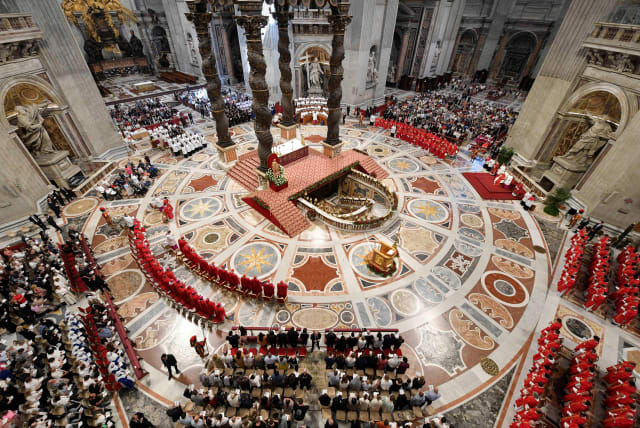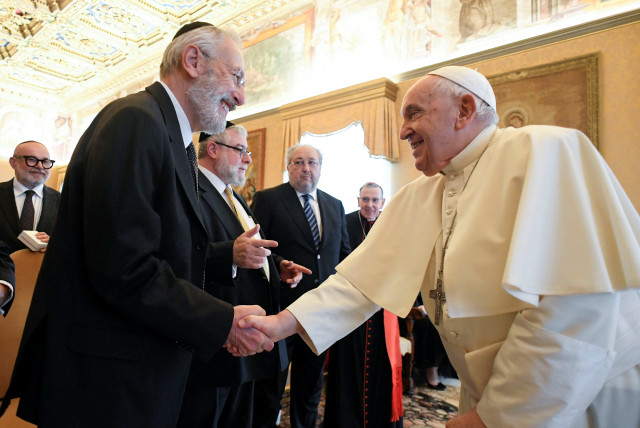What's true and false about the Vatican and Temple artifacts - opinion

Currently, the official Vatican position is that it neither confirms nor denies possession of Herodian Temple objects such as the golden Menorah, sacred tables, altars, and priestly garments.
A leading Italian member of parliament, who prefers to remain anonymous, held a Zoom meeting with Jerusalem Affairs and Heritage Minister Amihai Eliyahu in which he said that his country is prepared to return the lost Temple vessels to Israel – and that the time to do so is now, as reported last month by ISRAEL365. The reaction here in Israel has been overwhelming. Could this be true? The compelling article went viral across many faith-based Jewish and Christian communities.
Since then, including today, I have been receiving dozens of messages from around the world, including from news outlets, regarding the above-mentioned article. All are asking the same question: Is this real or fake news? So, I feel obligated to respond.
The answer is that there’s a little of both, i.e., some genuine news and some fake news.
In my capacity as director of the Museum Exchange Program, Jewish Heritage Project (located at the Vatican in Rome), I’m flattered that so many are reaching out; however, in order to respond, I need to shed light on some difficult truths. I have been in this fledgling position for approximately two years now, traveling back and forth from Israel to Rome and meeting with many of the Vatican directors personally, including those in charge of the excavations underneath St. Peter’s Basilica, the chief prefects at the dicastery for External Communications and the dicastery for Interreligious Dialogue (Catholic-Jewish relations), and museum directors – both past and present – as well as with all the Israeli ambassadors silently involved. I have found that almost all of these officials are in agreement, at least in theory, of temporarily displaying ancient Jewish antiquities.
That said, we must first understand that the Vatican Church and the government of Italy are two very distinct entities. Very distinct. There is no more profound example of the separation between Church and State than this. Also, we must take into consideration that Italy is a country of roughly 60 million citizens, while the Vatican has a religious constituency of over a billion Catholics. Furthermore, the Vatican Church has a power structure dating back to 1377, when Pope Gregory XI moved the official residence to that location; Italy, in comparison, became independent only in 1861 and was ruled by a monarchy until 1947, when the modern Italian republic was established. In addition, the Vatican enjoys complete diplomatic immunity, while Italy is subject to international laws and convention.
Official Vatican position is to neither confirm nor deny possession
Bottom line: Pope Francis, along with the Secretariat of State, His Eminence Cardinal Pietro Parolin; Governor Archbishop Fernando Vérgez Alzaga; and museum director Dr. Barbara Jatta, are the main decision-makers regarding this case. The Italian government can exert a limited amount of pressure by way of the press, but that’s about it.
The good news is that currently, the official Vatican position is that it neither confirms nor denies possession of Herodian Temple objects such as the golden Menorah, sacred tables, altars, priestly garments, and the like. This was said to me when I first attended the Apostolic Delegation of the Holy See, where I was granted an exclusive interview with the Papal Nuncio, His Excellency Archbishop Illana, at his residence on the Mount of Olives. What he said is no doubt a step in the right direction because for centuries, up until very recently, it was simply a given that the Vatican Church denies possessing any of these items.
Another development worth mentioning is that high-ranking Vatican officials were reportedly willing to reveal the location of these holy vessels to religious Jews before going on pension or resigning from their posts. These encounters, not merely one or two, are apparently taking place in Rome and even in Paris.
Second, I was in touch with the offices of the Italian MP cited in the ISRAEL365 article. What was written is indeed the opinion of this particular Italian politician; however, he is not the first to say that Rome has possession of Jerusalem’s Temple vessels and that he would like to see them returned, ultimately, to Israel. He added that these items are in the Vatican cellars – although he does not have concrete, academic proof – and that nothing is being done with them now at any rate.
According to Italian party platforms, the true recipients of the Temple treasures, in the meantime, should be the Jews in Rome who have lived there for centuries, dating back to the Spanish Inquisition. In other words, if the Italian government and press were to apply pressure on the various Vatican officials mentioned above (which I am personally pushing for), the group to benefit most would be the Roman Jews, their constituents, as the feeling is that it is their privilege – in fact, their right of heritage.
In the inner chambers where the highest Cardinals occasionally meet, the concept of restitution and/or repatriation to Israel is not even in the realm of discussion and in fact constitutes a potentially major theological problem for Catholicism in general and the Vatican Church in particular. Putting it bluntly, replacement theology is taking a hard hit here. It is for this reason that the proposal that I was asked to submit for filming these items and then facilitating an exhibit is actually quite limited to the Vatican Museums in Rome only, even if done as a symbolic gesture of solidarity with Israel vis-à-vis the war effort.
This leads to our third point. Pope Francis can make his sentiment known by lending support to the concept of a Jewish museum exhibition. In his public address, the Pontiff recently acknowledged that “it is the right of those who are attacked to defend themselves,” and he has issued guidelines to Cardinal Pierbattista Pizzaballa, the Latin Patriarch of Jerusalem and one of Pope Francis’s new crop of cardinals, for dealing with the current conflict. I’m assuming that one of those guidelines is the categorical reprehension and denouncement of all pro-Hamas rallies and riots, which promote the annihilation of an entire people, not only in Israel proper but wherever Jews may be. Just the other day, the Israeli flag was torn down by an angry Arab mob at the UN building in Rome.
Truth be told, Pizzaballa has a Catholic community in Israel, in the Palestinian territories, and in other places where there are tens of thousands of Christian Arabs, although not necessarily all are of the same opinion. This matters because one of the behind-the-scenes concerns of the Vatican lies with ascertaining how this large and vocal group would react to removing any Jewish items of antiquity for display and the political fallout. Would Christian Arabs in the Middle East have feelings of pride for the Pope, similar to when he donated the ancient Parthenon fragments back to Greece, or would it be turned into a political discussion regarding true ownership of the holy items. In other words, who were the indigenous people of Israel over 2,000 years ago, Palestinians or Jews? As I wrote in this newspaper over a year ago on the subject, nothing surprises me anymore.
In conclusion, there is a more realistic, practical way of making this Italian politician’s good intentions come true. Based on my work with this project, I’m pleased to say that what we do have now is scientific proof in the form of original epistles and correspondence letters, written in Latin, of sacred Byzantine-era antiquities – Jewish and Christian religious items from Syria and Constantinople, that were sent by the Latin Emperor Baldwin I to Pope Innocent III in Rome during April and May of the year 1204. This hoard of gifts reveals the Jewish origins of Christianity and therefore has tremendous spiritual and historical value. If you’re looking for something that is real and that is also located in the Vatican Museums, this is the ticket. Most experts agree with me that because these are rare imperial gifts, ‘Baldwin’s Treasure’ today is most likely to be found as part of the Vatican’s Treasury of St. Peter’s Collection or Pope Francis’ personal Papal Heritage Collection.
In the meantime, I am confident that the Jewish Heritage Project, together with the Vatican Museums, will continue to bear fruit and that we will have a major event announcement soon. Bringing Byzantine items out of preservation and back into the light after over 1,000 years might be one of the important steps that is needed to open the door, moving this MP’s dream forward, along with so many of our own.
The writer is director of the Museum Exchange – Jewish Heritage Project (Vatican City), a journalist, and president of Moskoff-Media (Israel), MMLC. He is also a member of the White House press pool and ICCROM. He can be reached at office@harryhmoskoff.net.
Jerusalem Post Store
`; document.getElementById("linkPremium").innerHTML = cont; var divWithLink = document.getElementById("premium-link"); if (divWithLink !== null && divWithLink !== 'undefined') { divWithLink.style.border = "solid 1px #cb0f3e"; divWithLink.style.textAlign = "center"; divWithLink.style.marginBottom = "15px"; divWithLink.style.marginTop = "15px"; divWithLink.style.width = "100%"; divWithLink.style.backgroundColor = "#122952"; divWithLink.style.color = "#ffffff"; divWithLink.style.lineHeight = "1.5"; } } (function (v, i) { });

